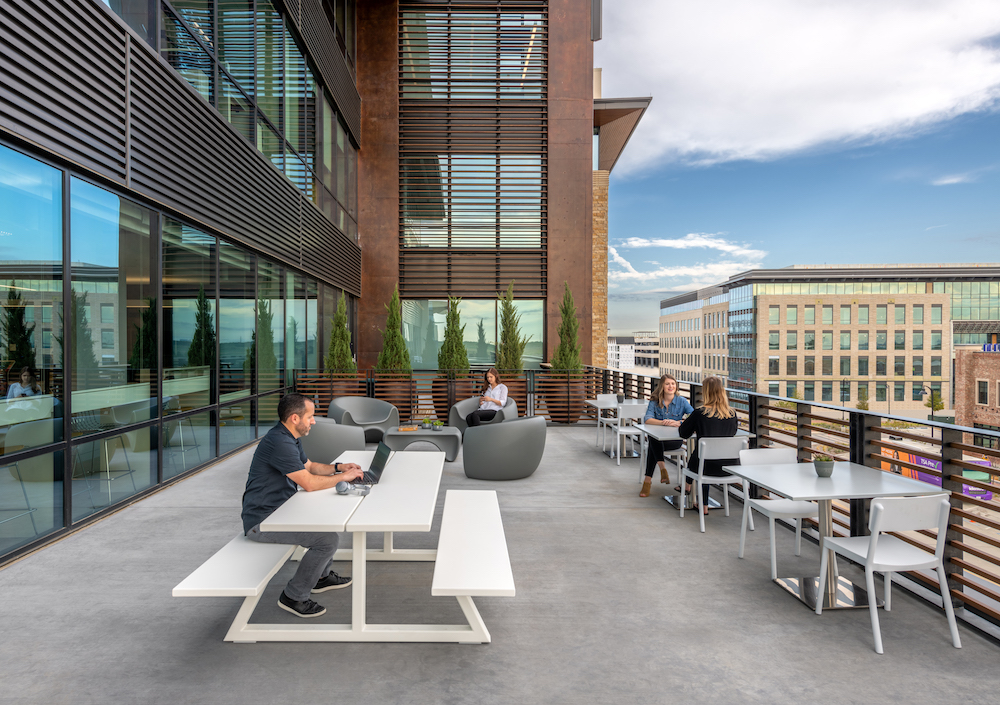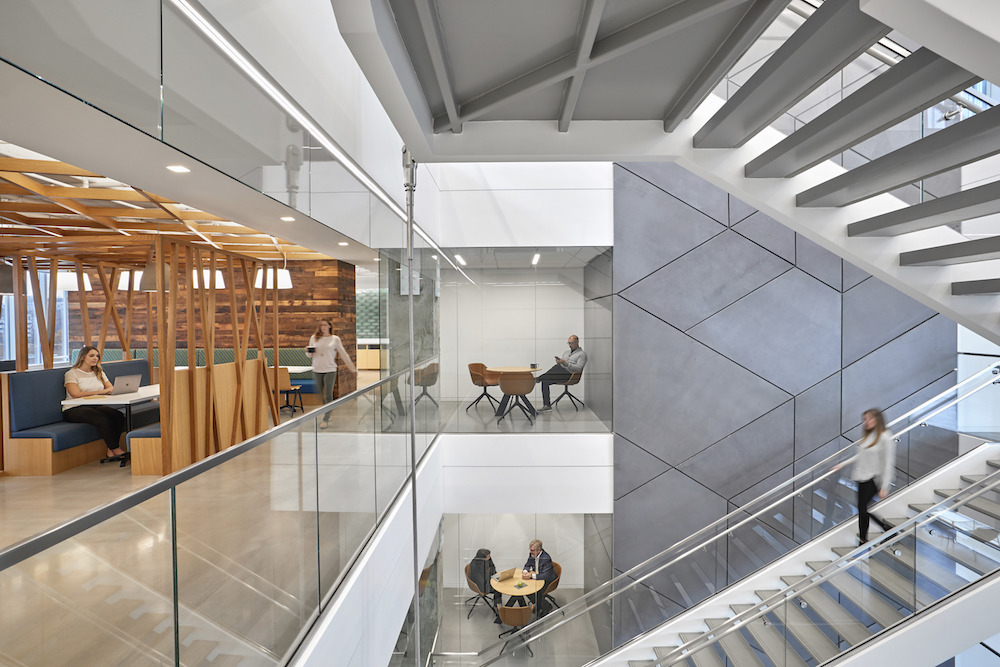CallisonRTKL’s Jodi Williams shares how using health-focused design can create stronger and more resilient built environments.

COVID-19 has shaped how people interact with their built environments. This crisis forced people to consider every choice they make in terms of how it affects their health—from travel, to entertainment, to the workplace. With health being top of mind, every interaction outside of our homes has become a cost-benefit analysis. Quickly running into the supermarket to pick up that forgotten ingredient for the new recipe or grabbing a bite to eat at a local deli are no longer simple tasks. Going into an office for a job was once a straightforward responsibility to which no one gave a second thought. Our team is constantly having health-focused design conversations to discover what the future workplace looks like, as well as how the workplace environment can support and enhance a lifestyle that focuses on wellbeing during the COVID-era and beyond.

Lessons Learned From Healthcare
As we have seen in healthcare spaces, clients focus heavily on evidence-based design. Protocols and procedures are established and followed precisely to ensure maximum safety. When the pandemic first hit, all market sectors looked to healthcare for cleaning and sanitation solutions, but quickly realized that set systems and processes would not be applicable during this time.
“Elements common to healthcare like sanitization, administrative versus engineering controls, and isolation have now become integral to the design of many sectors,” says Jim Henry, AIA, EDAC, Senior Vice President and leader of the CRTKL healthcare sector. “It’s become a continuing dialogue about making spaces healthier as opposed to something that is only relevant to one specific project or use type. We want to be able to implement these solutions globally, not just in one location.”
By looking at what we have learned in all built environments—from retail to hospitality to healthcare—design tools and strategies can be applied to unrelated practice areas. The workplace looked to healthcare first for inspiration and guidance on cleaning and sanitation, but were faced with challenges of their own. Without the proper cleaning systems already in place and appropriate workplace policies, offices found themselves with no solutions. For example, many organizations had policies that forbade cleaning staff from touching individuals’ personal items during cleaning. This type of regulation exists to ensure employees feel safe; however, it also limits the ability of staff to only clean about 50% of a desk and the communal areas. A simple solution became much more complex due to existing policies.
As people gradually return to the office, this type of regulation is shifting: placing the burden on employees to leave a clean desk at the end of the day, thereby permitting a deeper clean. Many organizations are taking this a step further and removing individually assigned space altogether and transitioning to a hoteling scenario, allowing each desk or office to be deep cleaned following use.
As offices continue to be redesigned, there are opportunities to borrow more from health sciences. For example, designers are looking to material selections: materials that are easily wipeable, bleach cleanable, and sometimes antimicrobial. Additional consideration goes into picking surface materials resulting in a shift away from more porous surfaces, such as natural wood, in high-touch areas. Installation methods can also be borrowed from health sciences, particularly regarding detailing and specifications for joints and seaming.

Taking Inspiration from Retail
Even prior to COVID-19, many believed the “death of the shopping mall” was imminent, leading to a rapid shift in the retail landscape to adapt to ever-changing consumer needs. As we experienced during COVID-19, curbside pick-up and contactless delivery have become the norm. Retailers quickly adjusted to the requirements of their shoppers to provide the most normal shopping experience possible. Retail also understands how to navigate people through a space while still keeping them engaged. Visual cues and furniture placement guide people through a store without needing someone to explain the proper flow of traffic. As workplaces are being redesigned with user safety at the forefront, adopting visual cues can help ensure employees feel comfortable once again without the feeling of sacrificing elements they love about the workplace like social interactions and coffee bars.
The retail industry blends entertainment, hospitality, and retail into cohesive mixed-use environments; workplaces are beginning to enter the mix. By creating a live/work space with assigned floors for specific activities, not only can people have easy access to their daily tasks but they can also have dedicated spaces for each activity. With the shift to working at home, people have been faced with the difficulty of separating work from life. Dynamic spaces that are all-encompassing while maintaining physical separation between work, live, and play enables improved work-life balance and benefits mental and emotional health.

Happiness is Key
When designing workplaces, pursue design solutions that drive productivity and efficiency while also ensuring all users are happy and healthy. Traditionally, happy and healthy workplaces have access to natural light, active workstations, and other lifestyle amenities. This pandemic forced workplace designers to evaluate what it really means to be healthy: no longer is health a binary measure of ill vs. not ill. Health is also measured in terms of social, economic, and mental wellbeing.
“In the workplace, social and mental well-being are driven by connections and relationships,” says Matt Billerbeck, AIA, Executive Vice President People & Culture and CallisonRTKL’s Human-Centric Design Initiative Leader. “With all the damage the pandemic has caused, one thing is certain: it has given us a shared experience that has become the global equalizer. I’ve witnessed people from various backgrounds and levels of seniority better able to connect and relate to one another.”
Senior Vice President Katie Sprague offers key work life values which guide not only our individual happiness, but also our return to office: personal freedom, vitality and wellbeing, authentic delight, and reaffirmed meaning. As she says, “May we use this Great Reset to reaffirm what we value, both in our personal lives and our work lives, as they merge together in new ways of being.”
By leaving the workplace and entering our homes, many have gained a better understanding of themselves and their coworkers. As we brought the office into our kitchens, and babies and dogs interrupted video conferences, employees quickly banded together to form stronger communities and found more commonalities. Leaders, managers, and individuals learned that remote work will not hinder the final work product and when people do choose to go back to the office, they will not be putting their fellow employees at risk
Providing choice is critical in driving employee happiness and engagement: when employees have some autonomy over when and where they work, they not only have the ability to choose what they feel is most productive for the task, but also what is most productive for their individual health, wellbeing and happiness – in the office or remote.
The pandemic has been more impactful to every aspect of life – including the workplace – than most anticipated; long term solutions are likely to continue to grow and evolve as the pandemic ebbs and flows. As things begin to reopen, we must continue to rely on each other and use everyone’s strengths to find the best solutions. By working across all industry sectors and bringing in healthcare, retail, or workplace experts to provide insight on all projects, our built environments will be stronger and more resilient to future changes.

